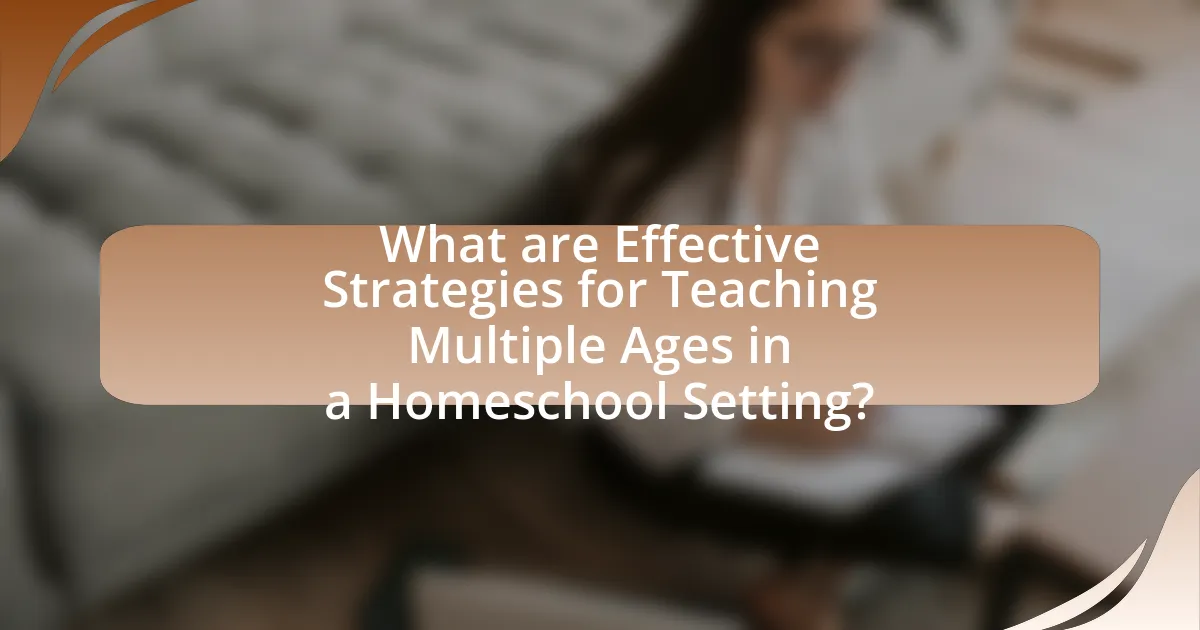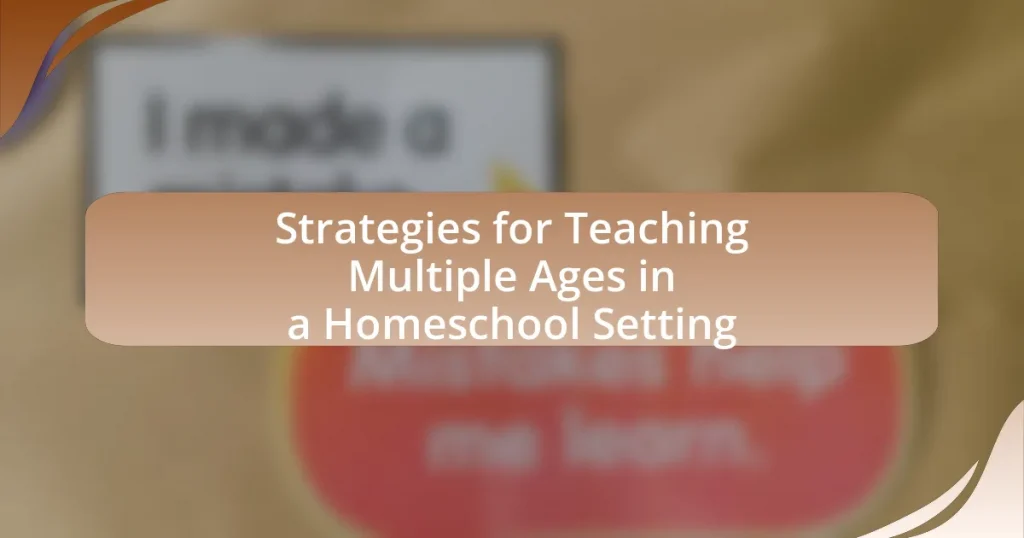The article focuses on effective strategies for teaching multiple ages in a homeschool setting, emphasizing the importance of individualized learning plans, thematic approaches, and integrated subjects. It outlines how parents can create a cohesive learning environment through structured routines and collaborative activities, while also addressing the challenges of managing diverse educational needs. Key elements for success include flexible curricula, project-based learning, and the influence of physical space on engagement. Additionally, the article discusses the role of technology and online resources in enhancing multi-age education, as well as best practices for time management and organization within a homeschooling framework.

What are Effective Strategies for Teaching Multiple Ages in a Homeschool Setting?
Effective strategies for teaching multiple ages in a homeschool setting include using a thematic approach, integrating subjects, and employing individualized learning plans. Thematic learning allows families to explore a central topic across different age groups, making it relevant for all learners. For example, studying ecosystems can involve younger children learning basic concepts while older students delve into more complex ecological systems. Integrating subjects, such as combining science with art or history, fosters a cohesive learning experience that engages all ages simultaneously. Individualized learning plans cater to each child’s unique needs and learning pace, ensuring that all students receive appropriate challenges and support. Research indicates that mixed-age learning environments can enhance social skills and foster collaboration, as older students often take on mentoring roles, benefiting both themselves and younger peers.
How can parents create a cohesive learning environment for different age groups?
Parents can create a cohesive learning environment for different age groups by implementing structured routines that accommodate varying developmental needs. Establishing a consistent daily schedule allows children of all ages to understand expectations and transitions, which fosters a sense of security and belonging. Research indicates that children thrive in environments where routines are predictable; for instance, a study published in the Journal of Educational Psychology found that structured routines enhance academic performance and behavioral outcomes across age groups. Additionally, parents can utilize multi-age teaching strategies, such as project-based learning, where older children mentor younger siblings, promoting collaboration and reinforcing knowledge. This approach not only strengthens family bonds but also cultivates leadership skills in older children, making the learning experience more enriching for everyone involved.
What are the key elements of a successful multi-age homeschool setup?
A successful multi-age homeschool setup includes individualized learning plans, flexible curriculum, and collaborative learning opportunities. Individualized learning plans allow each child to progress at their own pace, accommodating different learning styles and abilities. A flexible curriculum enables parents to adapt lessons to meet the diverse needs of multiple ages, ensuring that all children remain engaged and challenged. Collaborative learning opportunities, such as group projects or discussions, foster social skills and peer learning, enhancing the educational experience for all ages involved. These elements collectively create an effective and harmonious multi-age learning environment.
How does the physical space influence learning for multiple ages?
The physical space significantly influences learning for multiple ages by affecting engagement, comfort, and accessibility. A well-designed learning environment can enhance focus and motivation, which are crucial for effective learning across different age groups. For instance, research indicates that flexible seating arrangements and designated learning zones can cater to various developmental needs, allowing younger children to engage in active play while older students benefit from quiet study areas. Additionally, natural light and organized materials contribute to a positive atmosphere, which has been shown to improve retention and understanding of concepts. Studies, such as those conducted by the University of Salford, demonstrate that classroom design can impact academic performance, highlighting the importance of physical space in facilitating learning for diverse age groups.
What teaching methods are best suited for mixed-age classrooms?
Differentiated instruction is the best teaching method for mixed-age classrooms. This approach allows educators to tailor lessons to meet the diverse learning needs and abilities of students across different age groups. Research indicates that differentiated instruction can enhance student engagement and achievement by providing multiple avenues for learning, such as varied content, processes, and products. For example, a study by Tomlinson (2001) highlights that when teachers adapt their instruction based on students’ readiness, interests, and learning profiles, it leads to improved academic outcomes in heterogeneous classrooms.
How can project-based learning benefit students of varying ages?
Project-based learning benefits students of varying ages by fostering critical thinking, collaboration, and real-world problem-solving skills. This approach engages learners in hands-on projects that are relevant to their interests and experiences, making education more meaningful. Research indicates that project-based learning enhances retention of knowledge and improves student motivation across different age groups, as it allows for differentiated instruction tailored to individual learning styles. For instance, a study by Thomas Markham in “Project Based Learning Handbook” highlights that students involved in project-based learning demonstrate higher levels of engagement and achievement compared to traditional learning methods.
What role does individualized instruction play in a multi-age setting?
Individualized instruction is crucial in a multi-age setting as it allows educators to tailor learning experiences to meet the diverse needs and abilities of students. This approach acknowledges that children develop at different rates and possess varying interests, enabling teachers to provide personalized support that fosters engagement and mastery of concepts. Research indicates that individualized instruction can lead to improved academic outcomes, as it promotes a deeper understanding of material and encourages self-directed learning. For instance, a study by Tomlinson (2001) highlights that differentiated instruction in multi-age classrooms enhances student motivation and achievement by addressing individual learning styles and paces.
What challenges might arise when teaching multiple ages at home?
Teaching multiple ages at home presents challenges such as varying attention spans, differing educational needs, and resource allocation. Younger children often require more hands-on guidance, while older students may need independent study time, leading to potential conflicts in scheduling. Additionally, creating a curriculum that meets the diverse learning levels can be complex, as it necessitates balancing foundational skills for younger learners with advanced concepts for older students. Research indicates that families often struggle with time management and maintaining engagement across age groups, which can hinder effective learning outcomes.
How can parents manage different learning paces effectively?
Parents can manage different learning paces effectively by implementing individualized learning plans that cater to each child’s unique needs. This approach allows parents to assess each child’s strengths and weaknesses, enabling them to tailor lessons and activities accordingly. Research indicates that differentiated instruction can lead to improved academic outcomes, as it addresses the varying levels of understanding among students. For instance, a study published in the “Journal of Educational Psychology” found that students who received personalized instruction showed a 30% increase in engagement and retention compared to those in traditional settings. By utilizing resources such as online learning platforms, hands-on activities, and flexible scheduling, parents can create an environment that supports diverse learning paces, ensuring that each child progresses at their own rate while still feeling supported and challenged.
What strategies can help maintain engagement among diverse age groups?
To maintain engagement among diverse age groups, employing differentiated instruction is essential. This strategy involves tailoring teaching methods and materials to accommodate varying learning styles, interests, and developmental stages. For instance, using a mix of visual, auditory, and kinesthetic activities can cater to different preferences, ensuring that all age groups remain involved. Research indicates that differentiated instruction can lead to improved student engagement and achievement, as it addresses individual needs effectively. Additionally, incorporating collaborative projects allows learners of different ages to work together, fostering peer learning and social interaction, which further enhances engagement.

How can Curriculum be Adapted for Multiple Ages in Homeschooling?
Curriculum can be adapted for multiple ages in homeschooling by utilizing a multi-level approach that allows for differentiated instruction. This method involves creating a core curriculum that covers essential subjects while providing varied resources and activities tailored to different age groups. For instance, a single history lesson can include a read-aloud for younger students, while older students engage in independent research or project-based learning on the same topic. Research indicates that this approach not only fosters collaboration among siblings but also promotes critical thinking and adaptability, as evidenced by studies showing improved engagement and retention in multi-age learning environments.
What types of curriculum are most effective for multi-age learning?
Project-based learning and thematic units are the most effective types of curriculum for multi-age learning. These approaches allow students of varying ages to engage in collaborative, hands-on activities that promote critical thinking and problem-solving skills. Research indicates that project-based learning fosters deeper understanding and retention of knowledge, as it encourages students to explore real-world issues and work together, leveraging their diverse perspectives and skills. For instance, a study by Thomas Markham in “Project Based Learning Handbook” highlights that students involved in project-based learning demonstrate higher engagement and achievement levels compared to traditional methods.
How can parents select resources that cater to various age levels?
Parents can select resources that cater to various age levels by evaluating educational materials based on developmental appropriateness and adaptability. They should consider resources that offer tiered content, allowing for differentiation in complexity, such as leveled readers or multi-age curriculum guides. Additionally, parents can utilize online platforms that provide age-specific learning paths, ensuring that each child engages with material suited to their cognitive and emotional development. Research indicates that differentiated instruction enhances learning outcomes, as it addresses the diverse needs of children within a single educational setting.
What are the benefits of using thematic units in a multi-age curriculum?
The benefits of using thematic units in a multi-age curriculum include enhanced engagement, improved retention of knowledge, and the promotion of collaborative learning. Thematic units allow students of varying ages to explore a common topic, fostering a sense of community and shared purpose. Research indicates that when students engage with material in a thematic context, they are more likely to retain information due to the interconnectedness of concepts, as shown in studies by the National Center for Learning Disabilities. Additionally, multi-age settings encourage peer teaching, where older students reinforce their understanding by helping younger peers, thereby deepening their own learning.
How can technology enhance multi-age homeschooling?
Technology can enhance multi-age homeschooling by providing personalized learning experiences and access to diverse educational resources. Online platforms and educational software allow students of varying ages to engage with tailored content that matches their individual learning levels and interests. For instance, adaptive learning technologies can assess a student’s understanding and adjust the difficulty of tasks accordingly, ensuring that both younger and older learners are appropriately challenged. Additionally, resources such as virtual classrooms and collaborative tools enable multi-age groups to work together on projects, fostering peer learning and social interaction. Research indicates that technology integration in education can lead to improved student engagement and academic performance, as evidenced by a study published in the Journal of Educational Psychology, which found that students using technology in their learning environments showed higher motivation and achievement levels.
What online resources are available for teaching multiple ages?
Online resources available for teaching multiple ages include platforms like Khan Academy, which offers a wide range of subjects suitable for various age groups, and PBS LearningMedia, which provides educational videos and interactive content tailored for different grade levels. Additionally, websites such as Education.com and Teachers Pay Teachers offer lesson plans and activities that cater to diverse age ranges, allowing for differentiated instruction. These resources are validated by their extensive user bases and positive reviews from educators who utilize them for multi-age teaching environments.
How can educational apps support diverse learning needs?
Educational apps can support diverse learning needs by offering personalized learning experiences tailored to individual student preferences and abilities. These apps often include features such as adaptive learning algorithms that adjust content difficulty based on user performance, ensuring that learners of varying skill levels can engage effectively. For instance, a study by the International Society for Technology in Education found that personalized learning through educational technology can lead to improved student outcomes, particularly for those with learning disabilities. Additionally, educational apps frequently provide multimedia resources, such as videos and interactive quizzes, which cater to different learning styles, further enhancing accessibility and engagement for all students.

What are Best Practices for Managing Time and Resources in a Multi-Age Homeschool?
Best practices for managing time and resources in a multi-age homeschool include creating a flexible schedule, utilizing shared resources, and implementing group activities. A flexible schedule allows for adjustments based on the varying needs and learning paces of different age groups, ensuring that each child receives adequate attention. Shared resources, such as books and educational materials, can be used across multiple grade levels, maximizing efficiency and reducing costs. Group activities, like science experiments or art projects, foster collaboration and allow siblings to learn from one another, enhancing the educational experience. These strategies are supported by research indicating that multi-age classrooms can improve social skills and academic performance by promoting peer learning and engagement.
How can parents effectively schedule lessons for different ages?
Parents can effectively schedule lessons for different ages by creating a flexible timetable that accommodates the varying attention spans and learning paces of each child. For instance, younger children typically benefit from shorter, more frequent lessons, while older students can handle longer, more in-depth sessions. Research indicates that children aged 5-7 have an optimal attention span of about 15-20 minutes, whereas those aged 8-12 can focus for 30-45 minutes. By aligning lesson durations with these developmental benchmarks, parents can enhance engagement and retention. Additionally, incorporating overlapping subjects, such as teaching history through literature, allows for simultaneous learning across age groups, maximizing instructional time and fostering collaborative learning experiences.
What time management techniques work best in a multi-age setting?
Effective time management techniques in a multi-age setting include flexible scheduling, task prioritization, and the use of learning stations. Flexible scheduling allows educators to adapt lesson plans based on the varying needs and attention spans of different age groups, ensuring that all students remain engaged. Task prioritization helps in identifying essential learning objectives for each age group, allowing for focused instruction that meets diverse educational requirements. Learning stations facilitate independent work, enabling older students to assist younger ones while managing their own tasks, thus promoting collaboration and peer learning. These techniques are supported by research indicating that structured yet adaptable approaches enhance learning outcomes in multi-age classrooms.
How can parents balance structured lessons with free exploration?
Parents can balance structured lessons with free exploration by integrating both approaches into a cohesive learning environment. Structured lessons provide essential knowledge and skills, while free exploration fosters creativity and critical thinking. Research indicates that children benefit from a mix of guided instruction and opportunities for self-directed learning, as it enhances engagement and retention of information. For instance, a study published in the Journal of Educational Psychology found that students who experienced a combination of structured and exploratory learning performed better academically than those who engaged in only one approach. By scheduling specific times for structured lessons and allowing for unstructured play or exploration, parents can create a dynamic educational experience that meets diverse learning needs.
What tips can help parents stay organized in a multi-age homeschool environment?
To stay organized in a multi-age homeschool environment, parents should implement a structured schedule that accommodates the varying needs of different age groups. This can include creating a daily timetable that allocates specific time blocks for subjects, allowing older children to work independently while younger ones receive direct instruction. Additionally, utilizing a centralized organizational system, such as binders or digital tools, can help keep track of lesson plans, assignments, and progress for each child. Research indicates that structured environments enhance learning outcomes, as noted in a study by the National Center for Education Statistics, which found that organized educational settings contribute to improved student performance.
How can planners and tools assist in managing a diverse curriculum?
Planners and tools assist in managing a diverse curriculum by providing structured frameworks that accommodate various learning styles and age groups. These resources enable educators to organize lesson plans, track student progress, and align educational goals with individual needs. For instance, digital planners can facilitate the integration of different subjects, allowing for thematic units that engage multiple ages simultaneously. Research indicates that using curriculum mapping tools can enhance instructional coherence and ensure that all students receive a balanced education, as evidenced by studies showing improved learning outcomes in diverse classroom settings.
What are some common pitfalls to avoid when homeschooling multiple ages?
Common pitfalls to avoid when homeschooling multiple ages include failing to create a structured schedule, neglecting individualized learning needs, and underestimating the importance of engaging activities. A structured schedule helps manage time effectively, ensuring that each child receives adequate attention and instruction. Individualized learning is crucial because children of different ages have varying developmental stages and learning styles; ignoring this can lead to frustration and disengagement. Engaging activities are essential to maintain interest and motivation; without them, children may lose focus and enthusiasm for learning. These pitfalls can hinder the effectiveness of a homeschooling environment, making it vital to address them proactively.
What practical strategies can enhance the multi-age homeschooling experience?
Utilizing mixed-age group activities enhances the multi-age homeschooling experience by fostering collaboration and peer learning. This approach allows older children to reinforce their knowledge by teaching younger siblings, while younger children benefit from exposure to advanced concepts. Implementing project-based learning, where families work on a common theme or subject, encourages engagement across different age levels. Additionally, incorporating flexible scheduling enables families to adapt lessons to individual learning paces, ensuring that all children remain challenged and motivated. Research indicates that multi-age classrooms can improve social skills and academic performance, as evidenced by studies showing that students in such environments often exhibit higher levels of cooperation and problem-solving abilities.










